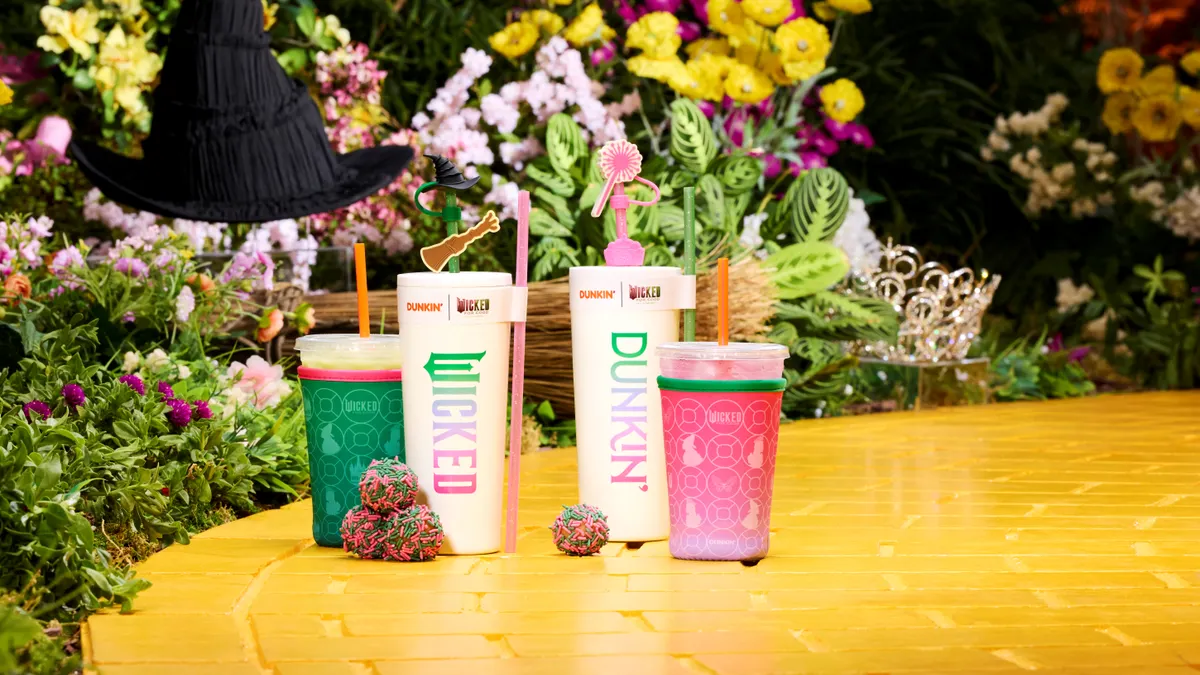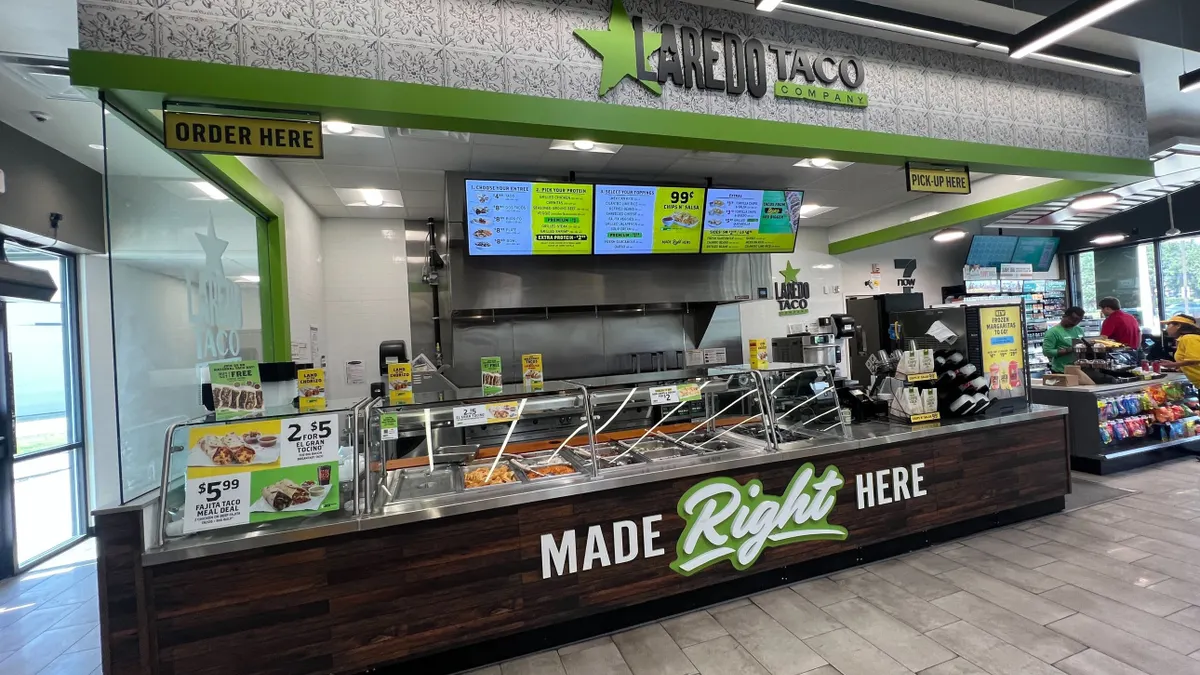As the restaurant space becomes increasingly crowded, QSR brands are stretching beyond their traditional brick-and-mortar locations to take their brands on the open road. Shake Shack and Auntie Anne's are just two major chains to invest in food truck fleets, which are no longer relegated to just local mom-and-pop fare, as they search for growth.
But these rolling restaurants aren’t necessarily going to help increase revenue. There’s another goal in mind.
"It’s all about marketing the brand," NPD Group vice president and food industry advisor David Portalatin told Restaurant Dive. "What the food truck does is it allows [QSRs] to play in the more experiential space to create that memorable moment, to provide customers something a little bit different or unique or attract people who may not have otherwise been in consideration and to convert them to the brand."
Food truck customer traffic increased 1% last year to 152 million customer visits, but total restaurant visits are about 61 billion annually, Portalatin said. While growth is steady in the food truck segment, it continues to expand, and brands across categories are capitalizing on the popularity of these mobile restaurants.
Red Robin, for example, hit the pavement for a three-and-a-half month, nine-state tour in early February to give fans free samples of steak fries. Wingstop also embarked on its own "Flavor World" tour throughout March and April, where its food trucks have offered fans a chance to win free wings for a year and the opportunity to star in a virtual ad.
But some restaurants are using food trucks to boost catering and off-premise business as well. Wayback Burger is rolling out compact, electric food trucks that can be used for catering and delivery and can cook burgers on the spot. For Auntie Anne's, which has plans to have 40 food trucks by the end of 2019, this avenue has allowed the pretzel brand to explore nontraditional means of reaching new and existing customers.
"Food trucks provide us the ability to be extremely accessible to our guests in the markets in which they operate, with an added benefit of providing a moving billboard for the brand in the communities we serve," Auntie Anne’s president Heather Neary told Restaurant Dive in an email. "Since we are primarily an impulse purchase, food trucks keep us top of mind to the consumer outside our traditional venue space and allow us to bring the Pretzels to the People across the nation."
"What the food truck does is it allows [QSRs] to play in the more experiential space to create that memorable moment ... or attract people who may not have otherwise been in consideration and to convert them to the brand."

David Portalatin
NPD Group vice president and food industry advisor
This new channel gives consumers access to Auntie Anne’s at sporting events, corporate functions, weddings, birthday parties, festivals and other events, Neary said.
"When we can 'meet' our guests at their life events, it’s impactful, and that’s our goal — to become ingrained in the lives of our loyal followers," Neary said.
Shake Shack Chief Development Officer Andrew McCaughan told Restaurant Dive that it jumped into food trucks after watching the space for some time — especially in Los Angeles, where Roy Choi's trucks have experienced growing popularity. It rolled out two trucks earlier this year in Atlanta and the New York/New Jersey as part of a pilot program.
"We decided to go for it after a lot of thinking, primarily because we heard so much of it from our guests," McCaughan said. "They wanted Shake Shack at an event, or wedding or corporations wanted to do events for employees and have these experiences that are more difficult to execute with renting griddles and setting up tents."
Making the dine-in experience portable
As these brands branch into new territory for both marketing and off-premise, they need to consider several different challenges surrounding liability, food safety and food challenges.
"The most important thing is it still needs to be all about the food," Portalatin said.
Despite space constraints, Auntie Anne's still follows the same baking procedures to deliver the same hot, golden brown pretzels available in stores, Neary said.
For Shake Shack, its biggest consideration is whether food trucks can replicate the dine-in experience while also integrating what hosts want to provide for their guests, McCaughan said.
"We're just trying to understand the business and make sure that what we do deliver with the trucks is a phenomenal Shake Shack experience," McCaughan said. "If we can deliver that, we'll see where it goes from there."
As Shake Shack continues its domestic and international expansion — with 36 to 40 units planned this year — food trucks will be a growing addition, he said.
"Off-premise is absolutely a growing category and we'll continue to watch it as we test these two trucks throughout this year and I'm sure we'll learn a lot," McCaughan said.
Risks and considerations
Launching a food truck fleet requires a bit of planning. Auntie Anne's, which has operated food trucks for two years, has learned a few things — especially when it comes to space. Logistics of packing is important for preparing what is needed for the day, Neary said. The internal layout of the truck needs to be optimal to accommodate efficiency while also making sure there is enough space for supplies, she said.
Flexibility has also been key for the chain since each event and booking opportunity is different, Neary said. That means having flexibility with its menu options, pricing, marketing materials and more to make sure the trucks meet specific consumer needs. Additionally, making it easy to find and book the trucks via its website is important for generating leads, she said.
"There are a lot of variables to go into specific events, but that is why our food trucks are so versatile and offer so much flexibility," she said.
Trucks at large events like a Rose Bowl pre-game tailgate or a community festivals will have to factor in how to serve thousands of people in a short window of time and consider what food and beverages are already available at the event, Neary said. It may serve Original or Cinnamon sugar pretzels to speed up service. The company also takes into consideration what beverages are available at the event — if the truck is next to a lemonade stand, for example, it wouldn't serve lemonade.
For small events, hosts pay upfront and order a customized menu for a specific amount of time and also have the option to add unique products like heart-shaped pretzels or pretzels shaped in a couple’s initials for weddings.
For Shake Shack, the company will be considering different elements that come into play with food trucks, such as maintenance and repairs and regulatory issues, as it considers whether or not to expand this venture, McCaughan said.
Other concerns for food trucks include greater likelihood of exposure to natural disasters, car accidents, slips and falls and other work-related injuries. Proper food storage to reduce food spoilage is also more challenging in mobile units, and liability insurance can cost into the thousands, according to QSR Magazine.
Despite these obstacles, the cost of setting up a food truck is particularly minimal compared to operating a physical brick-and-mortar location, Portalatin said.
A food truck costs tens of thousands of dollars compared to millions for a physical location, he said, and can allow broader access to different types of cuisine without a huge investment.
"Any time you have the ability to extend your brand to where people are as opposed to expecting them to come to you is a great opportunity," Portalatin said.



















